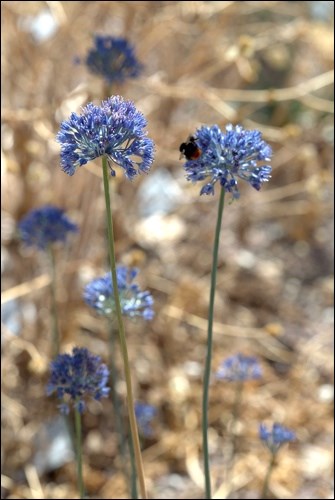You need a vivid imagination to perceive the lowly onion (Allium cepa), the odorous garlic (A. sativum) or even common chives (A. schoenoprasum) as particularly ornamental, yet with more than 400 species scattered around the world, the genus Allium provides dozens of plants which are not only extremely ornamental but have proven hardy on the Canadian prairies. The time to plant is now.
There is no mistaking that these plants are members of the onion family. Bruise a leaf and the characteristic smell is there. But the flip side is that the flowers of many of these species are indeed quite fragrant. And if you could ask any honeybee, it would tell you that Allium nectar is irresistible.
One common characteristic that many of these ornamental onions share is the development of bulbs as a storage organ for food and water. Typically, they produce a rosette of leaves early in the growing season, followed by flowering stems. Once flowers begin to open, their leaves dry and fall off and by mid-July only flower stalks and seed heads remain. This growth habit evolved in dessert species to take advantage of early spring moisture, escaping heat and drought through dormancy by late summer. Bulbous alliums are often over-planted with low annuals or perennial groundcovers. Rhizomatous ornamental onions, such as chives, maintain green foliage throughout the summer.
Their care is undemanding — good drainage and full sun. They thrive with a minimum of moisture. Some of these ornamental onions are both promiscuous and prolific. Dead-heading (removing the flower heads before they go to seed) is critical to prevent their sometimes-rampant spread.
Many lack common names but are available through garden centres and mail order catalogues by their Latin or botanical names. It might sound like a mouthful at first, but taking note of these will get you what you want.
Shorter alliums for the rock garden or front of the border:
Two yellow-flowered species (20-45 centimetres tall) are A. moly – a rich yellow with up-facing flowers – and A. flavum – a paler yellow with an airy more starburst appearance. Jeannine, a selection of A. moly produces flower umbels twice the size of the species. A strain of A. flavum called Fireworks is a mix of rose, yellow, white and purplish-pink. Within the same height range is A. oreophilum (aka A. ostrowskianum), a lovely apple-blossom pink with up-facing flowers. A. cernuum, native to North America, is a similar shade of pink, but with nodding flower heads. Put A. karataviense in a conspicuous spot. Low with large 12 centimetres flower heads, it has two or three very wide ornamental leaves that hug the ground in a couple of tight spirals. While the flowers of this species are typically a very pale pink, those of ‘Ivory Cream’ are a creamy white.
Mid-border alliums:
A. caeruleum (also listed as A. azureum) is somewhat taller with intense true blue flowers, a colour quite uncommon among the onions. A sphaerocephalum is noted for its tight head of red-purple flowers in mid-summer. The flower heads dry well, retaining their true colour. This species also prefers abundant summer moisture, unlike many of its relatives that much prefer a summer dry down. A. aflatunese and its variety Purple Sensation are a little taller (60-75 centimetres) and bloom a little later in late June or July with large (8-10 centimetres) rose-purple flower heads.
Allan Daku is a Saskatchewan-born horticulturist, now retired and twice as busy as he was when he was working.
— This column is provided courtesy of the Saskatchewan Perennial Society (SPS) (www.saskperennial.ca; hortscene@yahoo.com). Check out our Bulletin Board or Calendar for upcoming garden information sessions, workshops and tours: Fall Lily Sale, The Mall at Lawson Heights (Saskatoon), Oct. 2, 3 [note: The funds raised through the bulb sale are used to provide two scholarships for students studying Horticulture at the University of Saskatchewan and a bursary for students studying Horticulture at the Olds College of Agriculture,Olds, Alberta.]



